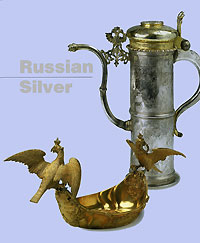Early Russia"s silver is highly original and artistic. Russian silversmiths evolved their own characteristic forms and decoration techniques that were not identical with ether Western or Oriental styles. In doing so, they did not alienate themselves from European or Asian influences, even though they did preserve their national sense of form and decoration. Thus, for example, the origin of the .contours of the loving cup, which had analogues in the metal-work of some Oriental peoples, is open to dispute. By the sixteenth century, the heyday of ancient Russian silversmithing, it was already an exclusively Russian form, with soft yet resilient clear-cut outlines. Its design is an architectonic whole by virtue of the precisely calculated proportions of all its components. Even more refined are Russian dippers with their underlying imagery. The best of them are true masterpieces of form. Dippers in the shapes of boats or swans were virtual odes to the broad expanses of Russian"s unhurried rivers quietly flowing through her boundless fields and meadows. As a rule, up to the eighteenth century, the shape of the dipper was very simple. Its very simplicity, however, was exquisite for its precision, smoothness, stylishness and full conformity to its function. Ancient Russian silver is no less remarkable for its decoration. The wealth of ornamental designs found in Russian wood carvings and embroidered or painted decorations were translated by Russian silversmith into nielloed, incised or chased adornments on the smooth gleaming surface of the silver vessel. Plant designs,tespecially grass stalks, predominate, covering either the entire surface or just the sides gently sloping from the crown. The designs are harmoniously entwined with engraved inscriptions. Occasionally the ornaments are somewhat crude and inaccurate pictorially, but they are expressive and dynamic and bespeak a daring and confident hand. As an old connoisseur of Russian silver put it, they express everything boisterous, sonorous, ornate and fanciful that Russian art has to offer. Gradually, from the second half of the seventeenth century and especially from the times of Peter I onwards, the life-styles in Russia underwent changes, and so did objects for everyday use. The Russian silversmiths were actively mastering the western forms and decoration techniques. Their wares dating from the middle of the seventeenth century demonstrate what wonderful fruit was begotten by the marriage of the Russian and the European. These objets d"art are fascinating in their ingenuous naivete, and what is most in evidence is the desire of the maker to master the new idiom, which was at times not so easy to grasp. Ornamentation changed faster than anything else, Quite often such foreign motifs as tulips, lambrequins and rocaille scrolls were applied to typically Russian forms. By the time of Catherine II, however, the leading Russian silversmiths were advancing almost neck and neck with their Western counterparts. Like old customs, some old types of silverwares receded into the past. Nevertheless, the dipper would long retain its currency as a presentation article awarded for services. In the second half of the nineteenth century, when there was a revival of interest in early Russian silver and the Russian masters re-established its high repute, the dipper made yet another comeback as a valuable gift. In the nineteenth and twentieth century, Russian silversmiths and jewellery designers remained faithful to their historical roots - their constant source of inspiration - and went on perfecting traditional forms; they also created novel ones to reflect the influence of their contemporary culture combined with love for national traditions. To generations of their successors, their art became not only the hallmark of great skill, but also a proof of love for their country and its cultural heritage.
Красочно иллюстрированное издание на английском языке.
Формат 25 х 31 см. Это и многое другое вы найдете в книге Russian Silver
